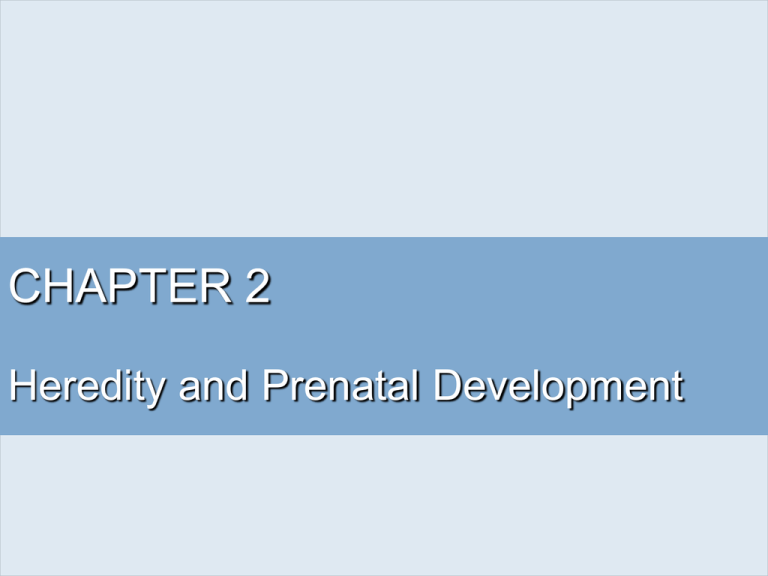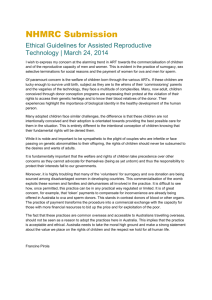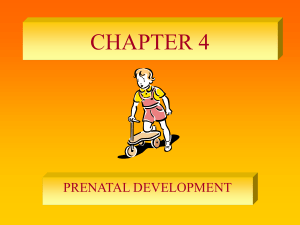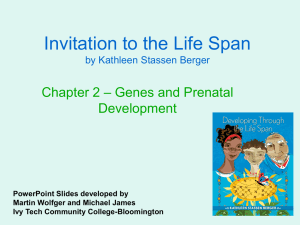CHAPTER 2 Heredity and Prenatal Development
advertisement

CHAPTER 2 Heredity and Prenatal Development The Influence of Heredity on Development Chromosomes and Genes • Genetics - the field of biology that studies heredity – Fundamental in the transmission of physical traits – Also plays a role in psychological traits • Chromosomes – Rod-shaped structures composed of genes that are found within the nuclei of cells • Gene – The basic unit of heredity. Composed of DNA • Polygenic – Resulting from many genes • Deoxyribonucleic Acid (DNA) – Genetic material that takes the form of a double helix composed of phosphates, sugars and bases. Identical and Fraternal Twins • Monozygotic (MZ) - Zygote divides into two cells that separate so that each develops into an individual with the same genetic makeup. • Dizygotic (DZ) - Two ova are produced in the same month, each fertilized by a different sperm cell. • Ovulation - As women reach end of childbearing years, ovulation becomes less regular. -Results in months when more than one ovum is released Chromosomal and Genetic Abnormalities • Down syndrome – Caused by an extra chromosome of the 21st pair, resulting in 47 chromosomes • Characteristic features -rounded face -protruding tongue -broad, flat nose -sloping fold of skin over the inner corners of the eyes • Show deficits in cognitive development and motor development Genetic Counseling and Prenatal Testing • Genetic counselors compile information about a couple’s genetic heritage to explore if their children will have a genetic abnormality. • Couples with likelihood of passing on genetic abnormality tend to adopt or not have children of their own. • Prenatal testing can indicate if the embryo or fetus is carrying genetic abnormalities. Amniocentesis • Performed on mother 14-16 weeks after conception • Syringe withdraws fluid from the amniotic sac; contains cells sloughed off by fetus • Cells separated, grown in culture, and examined for genetic and chromosomal abnormalities • Routine for women over 35 to detect for Down syndrome; other chromosomal abnormalities increase dramatically as women approach 40 • Amniocentesis carries some risk of miscarriage. Chorionic Villus Sampling • Carried out between 9th and 12th week of pregnancy • Syringe inserted through vagina into uterus to suck out threadlike projections (villi) from the outer membrane that covers the amniotic sac and fetus • Results available in days • CVS slightly greater risk than amniocentesis of miscarriage; both increase the risk of miscarriage Ultrasound • Sound waves that are too high in frequency to be heard by human ear obtain information about the fetus • Ultrasound waves are reflected by the fetus; computer uses the information to generate a picture of the fetus • Picture is termed a sonogram • Used to guide the syringe in amniocentesis and CVS by determining the position of the fetus • Used to track growth of fetus, detect multiple pregnancies, detect structural abnormalities Blood Tests • Used to identify sickle-cell anemia, Tay-Sachs disease, and cystic fibrosis • Alpha-fetoprotein (AFP) used to detect neural tube defects such as spina bifida and chromosomal abnormalities • Neural tube defects cause elevation in the AFP level in the mother’s blood • Elevated AFP levels related to increased risk of fetal death Heredity and the Environment Heredity and Environment • Inheritance, nutrition, learning, exercise, accident, and illness contribute to development of traits • Genotypes -Set of traits we inherit from our parents • Phenotypes -Actual set of traits -Both genetic and environmental influences Kinship Studies • The more closely people are related, more genes they have in common • Parents and children have 50% genetic overlap • Siblings have 50% genetic overlap • Aunts, uncles have 25% overlap with nieces and nephews; grandparents, 25% overlap with grandchildren • First cousins have 12.5% overlap Twin Studies • Monozygotic (MZ) twins share 100% of genes -MZ twins resemble each other more closely than DZ twins on a number of physical and psychological traits. -MZ twins more likely to look alike and be similar in height -MZ twins more likely to share autism, depression, schizophrenia, and vulnerability to alcoholism • Dizygotic (DZ) twins share 50% of genes; same as other siblings Adoption Studies • Children that are separated from their natural parents at an early age and reared by adoptive parents provide special opportunities for sorting out nature and nurture. • When children who are reared by adoptive parents are nonetheless more similar to their natural parents in a trait, a powerful argument is made for a genetic role in the appearance of that trait. – Examples: Psychological disorders, addiction Conception: Against All Odds Conception • Conception refers to the union of an ovum and a sperm cell. • Ova – Women born with all the ova they will ever have, about 400,000 – Released from ovarian follicle and enter fallopian tube; 3-4 days later, egg propelled by small, hairlike structures called cilia, and perhaps, by contractions in the wall of the tube • If egg not fertilized, discharged through the uterus and vagina, along with endometrium that had formed to support an embryo, in the menstrual flow; during reproductive years, about 400 ova will ripen and be released Conception (cont’d) • Ova are larger than sperm, barely visible to the eye • Sperm cells develop through stages; sperm with Y sex chromosomes swim faster than sperm with X sex chromosomes. • Male fetuses suffer a higher rate of miscarriage than females, often during the first month of pregnancy. • 150 million sperm ejaculated, only 1 in 1,000 can approach an ovum Infertility • Infertility problems with men - Low sperm count (most common) - Lack of sperm - Genetic factors - Environmental poisons - Diabetes - Sexually transmitted infections - Overheating of the testes - Pressure (e.g., bike seats) - Aging - Certain prescription and illicit drugs Infertility (cont’d) • Infertility problems with women - Irregular ovulation, lack of ovulation - Irregularities among the hormones that govern ovulation, stress, and malnutrition - Pelvic inflammatory disorder (PID) -infection that scars the fallopian tubes and other organs, impeding the passage of sperm -Endometriosis -can obstruct the fallopian tubes Infertility Options • Artificial insemination -Sperm is collected and quick-frozen -Sperm then injected into woman’s uterus at time of ovulation; addresses low sperm count as well as low sperm motility -Can be used for a woman to get pregnant who does not have a partner • In vitro fertilization -Ripened ova are surgically removed from the mother and placed in laboratory dish; father’s sperm also placed in dish -One or more ova fertilized and injected into mother’s uterus to become implanted -Used when fallopian tubes are blocked or father has low sperm motility -A donor can be used Infertility Options (cont’d) • Donor IVF -Mother does not produce ova -Ovum from another woman is fertilized and injected into the uterus of the mother-to-be • Surrogate mothers -Mothers who bring baby to term for other women who are infertile -Can be artificially inseminated by partner of infertile woman • Adoption -Another way for people to obtain children that results in the formation of loving new families Preimplantation Genetic Diagnosis (PGD) • Reliable method for selecting the sex of the child prior to implantation • Ova are fertilized in vitro • After a few days of cell division, cell is extracted from each • Sex chromosomal structure of the cell is examined microscopically to determine its sex • Embryos of desired sex are implanted in the woman’s uterus Prenatal Development Prenatal Development • Normal gestation period 280 days; from date of fertilization 266 days • Divided into three periods 1. Germinal stage (Weeks 0 - 2) 2. Embryonic stage (Weeks 3 - 8) 3. Fetal stage (Weeks 9 - Birth) The Germinal Period • • • • First two weeks after conception Creation of the fertilized egg (the zygote) Cell division Implantation -- the attachment of the zygote to the uterine wall – takes place about 10 to 14 days after conception The Embryonic Period • Occurs from two to eight weeks after conception • Rate of cell differentiation intensifies • Every body part eventually develops – Neural tube – Organogenesis -- the process of organ formation during the first two months of prenatal development • organs are especially vulnerable to environmental influences The Fetal Period • Fetal period begins two months after conception (normal gestation is 38-40 weeks) • Three months after conception -- fetus is about 3 inches long; weighs about 3 ounces • By the end of the fifth month, the fetus is about 12 inches long and weighs close to a pound – Vernix – Lanugo • At birth, the average American baby weighs 7½ pounds and is about 20 inches long Three Trimesters • The germinal and embryonic periods occur in the first trimester • The fetal period begins toward the end of the first trimester and continues through the second and third trimesters • Age of Viability (the chances of surviving outside the womb) occurs at the beginning of the third trimester – About 24-25 weeks after conception Environmental Influences on Prenatal Development • Maternal malnutrition effects -low birth weight -prematurity -retardation of brain development -cognitive deficiencies -behavioral problems -cardiovascular disease • Fetal malnutrition can sometimes be overcome by a supportive, care-giving environment. • Supplementing diets of pregnant women shows positive effects on motor development of infants. • Maternal obesity linked with higher risk of stillbirth Environmental Influences on Prenatal Development (cont’d) • Women should gain between 25-35 pounds -Overweight women may gain less -Slender women may gain more • Teratogens -Environmental agents can harm the embryo or fetus -Includes drugs taken by mother, lead, mercury • Pathogens -Disease-causing organisms -Bacteria and viruses Environmental Influences on Prenatal Development (cont’d) • Critical periods refer to the times when organs are developing. • Particular teratogens at a particular time can be harmful to the fetus. • Sexually transmitted infections such as syphilis and HIV/AIDS can affect the development of the fetus. -Routine blood tests are given early in pregnancy to diagnose syphilis Drugs Taken by the Parents (cont’d) Alcohol • Heavy alcohol consumption during pregnancy can result in fetal alcohol syndrome (FAS). • FAS babies -often smaller, with smaller brains -facial features include widely spaced eyes, underdeveloped upper jaw, flattened nose • Psychological characteristics appear to reflect dysfunction of the brain. • Maladaptive behaviors such as poor judgment, distractibility, and difficulty perceiving social cues are common. Drugs Taken by the Parents (cont’d) Caffeine • Research regarding caffeine consumption is inconsistent -Several studies have found that pregnant women who take in a good deal of caffeine are more likely than nonusers to have a miscarriage or a low-birth-weight baby. Drugs Taken by the Parents (cont’d) • Cigarettes – Consist of nicotine, carbon monoxide, and hydrocarbons (tars) -Nicotine and carbon monoxide pass through placenta and reach the fetus -Nicotine stimulates the fetus; long-term effects unknown -Carbon monoxide decreases amount of oxygen available to the fetus -Connected with impaired motor development academic delays, learning disabilities, mental retardation, and hyperactivity • Smokers’ babies likely to be smaller than those of nonsmokers -Babies of smokers more likely to be stillborn or to die soon after birth • Men who smoke are more likely to produce abnormal sperm. -Babies of fathers who smoke have higher rates of birth defects, infant mortality, lower birth weights, and cardiovascular problems. Parents’ Age • Older fathers more likely to produce abnormal sperm • 20’s ideal age for women to bear children • Teenage pregnancy can result in higher incidence of infant mortality and low birth weight. • Stillborn or preterm babies increase as age of mother increases; adequate prenatal care decreases this likelihood even for first-time older mothers.






